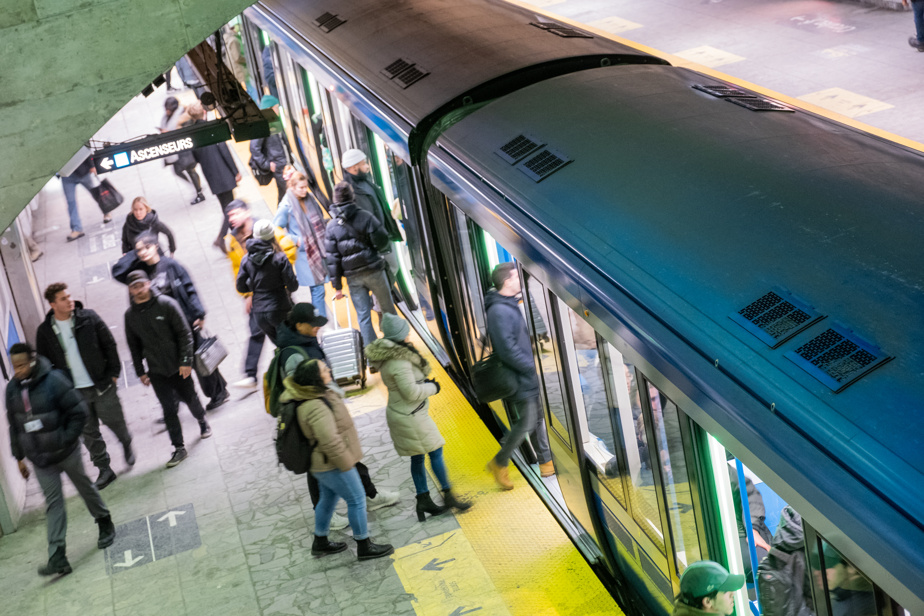Montreal will have to increase 715 million for public transport next year, a jump of 48 million compared to last year. The increase in spending is mainly attributable to the extension of the blue line, the Réseau express métropolitain (REM) as well as the fare reduction intended for people aged 65 and over.
Next year alone, nearly 8 million will be invested for “incidental works” around the REM, which is due to inaugurate several new stations in downtown and in the west of the island in 2024.
The City, which says it wants to ensure “that CDPQ Infra integrates municipal orientations into the REM project in order to respect the needs of the population” in terms of developments and urban integration, plans to extend 39 million around the train project light by 2023, and 49 million by 2033.
In the short term, free travel on the metro and buses for seniors will weigh heavily in 2024. It will cost the City around 34 million next year, compared to 24 million last year, a difference which can be explained by the fact that in 2023, the measure did not come into force until the summer.
The rest comes from a contribution to the work of extending the blue line. A sum of 3 million will be devoted to it next year, but will increase rapidly over time to reach 65 million by 2028 and 154 million by 2033.
In short, including a few other related costs, the City’s total contribution to the Regional Metropolitan Transport Authority (ARTM) will therefore jump by 48.4 million, going from 667.2 million to 715.6 million, the equivalent of 10% of the budget.
Still a lack of answers
However, we do not know whether this total contribution will cover the shortfall of the Société de transport de Montréal (STM), since the ARTM has not yet released its budgetary framework, which specifies the revenues and the operators’ share. This should be done by next Tuesday.
It’s a bit of a shame to adopt a budget without knowing what contribution will be requested from transport companies. […] Once we have the scenarios, we will have to adjust. Of course, our desire is not to affect the quality of service.
Valérie Plante, mayor of Montreal
She considers in passing that the criticisms concerning free admission for seniors are unfounded, since this expense is linked to the budget and not to the contribution of the ARTM. “In no way does it affect the contribution we make to the deficit. On the contrary, as our contribution is based on the number of passengers, the more seniors I have who enter the metro, the more money I give to the ARTM. »
In its so-called “preliminary” budget published this Wednesday, the STM still says it expects to carry an imposing deficit of 35.6 million, as revealed The Press Wednesday. The operator also fears having to eliminate 120 positions and reduce its expenses by 50 million to avoid reducing service.
“We are here to maintain the service offering,” cautiously raised the president of the transport company, Éric Alan Caldwell, deploring once again that the lack of structural funding in public transport “has repercussions on the Authority’s revenues. regional and, ultimately, on STM expenses.”
526 million for the road network
The road network will benefit from municipal investments of around 526 million for 2024, which represents 6.1% of the budget. Unsurprisingly, the money will mainly go to major projects, such as avenue des Pins, the Jacques-Bizard bridge, Camillien-Houde avenue or even rue Jean-Talon Est. Work on the latter, for example, will cost the City around 131 million over the next 10 years.
In total, a significant investment of 4.7 billion is planned in the long term for the rehabilitation of road infrastructure, including more than 840 million in the leveling-surfacing programs on the arterial and local network, which aim to avoid the proliferation of potholes. A sum of approximately 1.1 billion is also anticipated for the reconstruction of local streets and the repair of aqueduct networks.
The City plans to invest 15 million per year, for a total of 150 million within 10 years, in “safety measures” around schools and places frequented by the elderly, who are over-represented in collision statistics. Several pedestrian priority lights will be added throughout the island.
“We are going to secure 33 new schools and launch a call for projects to secure the movement of elderly pedestrians. We will also secure 20 new crossings, among other things, thanks to the hiring of 20 new brigadiers,” mentioned Mr.me Plant. The total number of brigadiers will now reach 640.
Valves open for BIXI and REV
The backbone of Montreal’s cycling network, the Réseau express vélo (REV), is not to be outdone. It will receive 30 million per year from 2024 until at least 2033. Extensions of the REV of approximately 5.3 km are planned in the near future, including on the Saint-Antoine and Saint-Jacques axes. On the bike-sharing side, BIXI will receive around 16.4 million next year to continue its development, in addition to 6.2 million for the electrification of its fleet. This is a notable increase in expenses, at a time when the organization is attempting for the first time this year to deliver the service year-round. Montreal wants to “increase the current fleet” of BIXI by 50% over a period of five years. From 2024, we will add more than 1,000 bicycles and install nearly 100 stations. Over a period of 10 years, a sum of 100 million is finally planned to “correct the deficiencies observed on the surface of cycle paths, which will improve their comfort and safety”.
